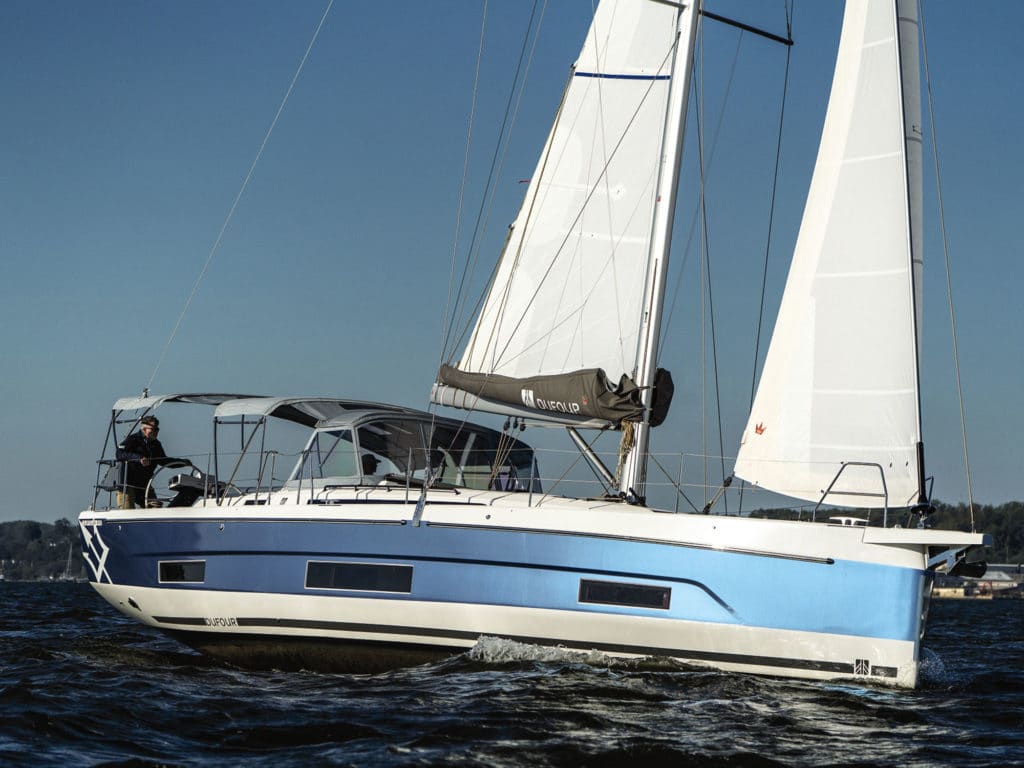
In a year disrupted by pandemic-related workforce distractions, supply-chain woes and an overhaul of its woodshop, Dufour Yachts, one of France’s most prolific sailboat builders, still managed to launch more than 350 vessels, including two new models introduced to North America during the US Sailboat Show in Annapolis, Maryland, this past October.
Making their debuts were the performance-cruiser Dufour 470 and a new company flagship, the Dufour 61. Like all Dufours built over the past two decades, the latest in the range come from the drawing board of Umberto Felci, working alongside the in-house design team. The latter now includes input from catamaran builder Fountaine Pajot, whose ownership group bought Dufour three years ago.
Over time, the result of such close collaboration has been a brand with a strong visual identity and features that tend to be introduced in one model and then incorporated into the rest of the range. At present, the Dufour lineup includes nine models, ranging in size from the yet-to-be-seen (here in the US, at least) Yacht Dufour 32 to the 61.
Some of the features introduced in recent years include a galley-forward layout, which leaves the beamiest part of the boat open for living and entertaining; self-tacking headsails as an option in place of overlapping genoas; and an outdoor galley on the transom. Several of these elements are now available on models throughout the range, and based on the other new sailboats we saw this past fall in Annapolis, they are ideas that are gaining traction with other builders as well.
But while Felci and Dufour have adopted other trendy design elements, such as chined hulls and twin wheels, they’ve steered clear of twin rudders, opting instead for a single deep foil that provides ample control while backing and sailing, thanks in part to hull forms that favor diminished angles of heel.
Discussing the brand in general terms, Boat of the Year judge Tim Murphy spoke for his colleagues, saying that during sea trials, they’ve come to expect lively sailing performance from Dufour yachts, thanks in part to sails, gear, and deck layouts that reward sailors keen on tweaking lines to control sail shape and trim.
Let’s start with the 470, which was the first boat I visited alongside the BOTY judges.
It was an easy step aboard from the dock, thanks to the wide fold-down transom that doubles as a spacious swim platform. Beneath the cockpit sole to starboard, we found an ample-size life-raft locker; to port, two steps take you past the fold-up helm seat and into the cockpit itself.
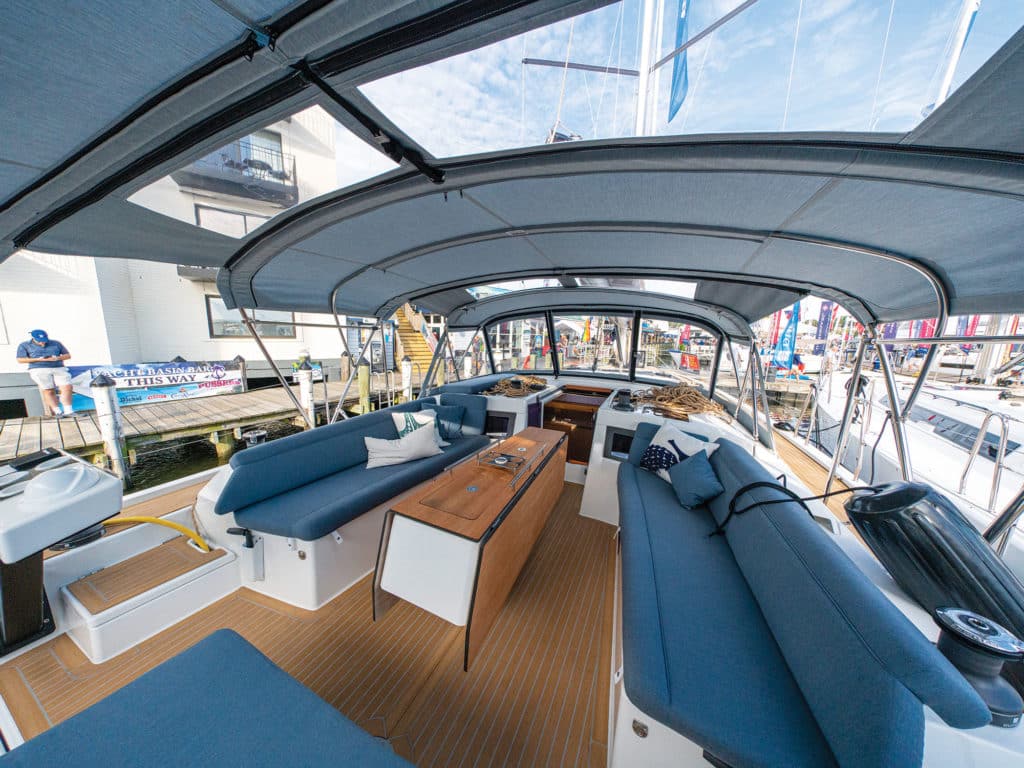
One reason for the proliferation of twin wheels these days is the wide beam that’s carried aft on many boats. Usually the space between helms is left open, but on the 470, it’s put to good use with a large padded lounge area, which I must admit looked like an inviting place to spend time off watch. It was designed so there’s still good access to the cockpit proper. And while sailing, I didn’t find it in the way when stepping between wheels that are mounted on pedestals well outboard to free up space around the drop-leaf table that sits between the cockpit settees.
Another cockpit element that I thought worked quite well are the steps up to the side deck, located just forward of each wheel. One per side, these provide a simple, neat solution to the dilemma of how to clamor over coamings to go forward, plus they double as line-storage bins for the adjacent winches.
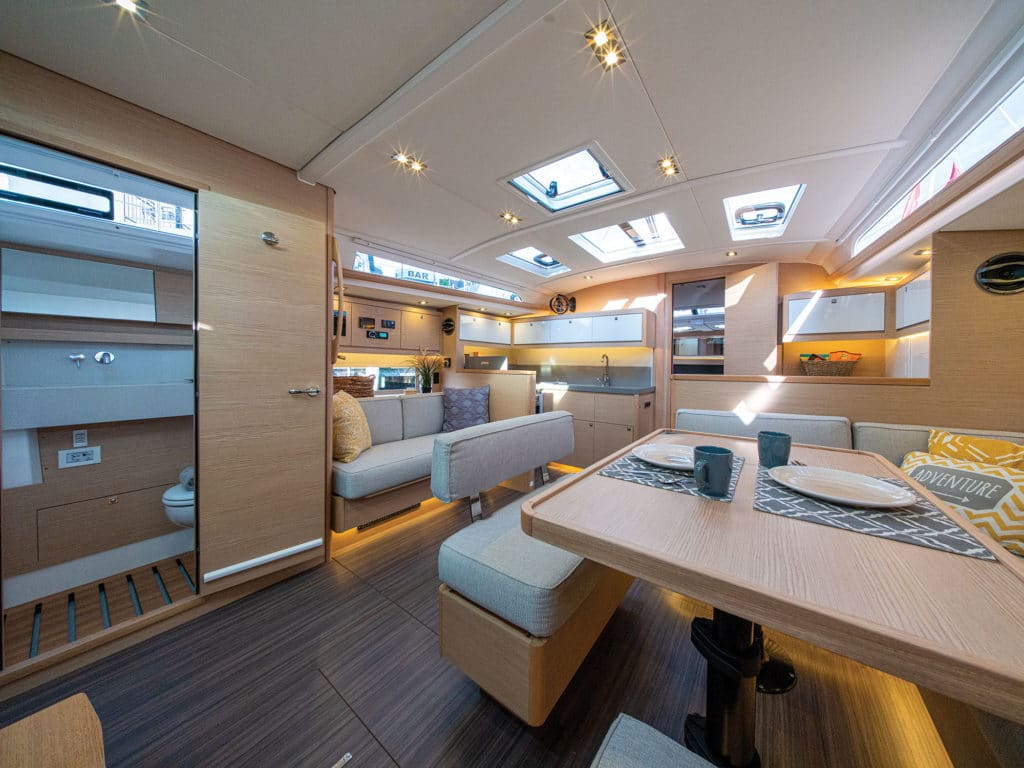
The 470, like other Dufour models, is available in three levels of gear and deck layout, depending on how an owner plans to use the boat. Easy, intended for the casual sailor or charterer, gets you a self-tending jib and in-mast furling main, both with halyards and sheets running to a pair of winches on the cabin top. The boat we toured and sailed was set up as an Ocean version, with a pair of Lewmar winches at each helm for main and jib sheets, as well as two more winches on the cabin top for halyards and sail-control lines. Our boat was fit out with a traditional main that’s stored in a boom pouch and a self-tacking jib. But fairlead tracks on the side decks also allow for a genoa; on the bow, there’s a sprit for flying off-wind sails that also incorporates an anchor roller. A beefy traveler sits just forward of the dodger, providing more control over the main.
The Performance version of the 470 includes additional sailhandling gear, plus end-boom sheeting for the main, with an anchor point in the cockpit sole just forward of the wheels. The latter two versions can also be set up with a double-ended German-style mainsheet, meaning the skipper has control of the sail at either wheel.
Down below, the 470 is available in four layouts, all with the galley forward, adjacent to the main bulkhead. Included in the design is a feature I’ve really liked on other Dufours: large overhead hatches that span the cabin top just aft of the mast and let tons of light into the interior. Accommodations span from three cabins and two heads, which we found on the boat we sailed, to four cabins and four heads, or four cabins plus a Pullman berth and three heads. As I said, there are options.
Dufour uses foam core above the waterline and solid fiberglass below in its infused composite hulls. Decks are also infused, and a composite grid is bonded to the hull before furniture and systems are installed to carry loads from the keel, engine and rig.
The 470 we sailed is available at a sail-away price right around $600,000. This includes Raymarine electronics, a bow thruster (a stern thruster is an option), and a 60 hp Volvo engine and saildrive; an 80 hp powerplant is also available.
We had a decent breeze—about 12 knots—to start with on the afternoon we went for a sail. Closehauled, the speedo hovered just under 6 knots. Off the wind on a beam reach and in less breeze, maybe 8 knots, the speed dropped to the mid-4-knot range. If I were buying the boat, I’d definitely spring for a code zero or other reaching sail to keep things lively. From either helm, sightlines forward, past the Bimini and dodger, were OK, and their frames doubled as excellent handholds when stepping onto the side decks to go forward.
Unfortunately, we sailed the 61 earlier in the day, when in a week of nearly perfect conditions, we were skunked for breeze. But powering along with the boat’s 175 Volvo with shaft drive, we scooted right along at 8.7 at the suggested cruising rpm and added another knot when we opened the throttle wide in get-home-quick mode. This hinted at what we might have seen under sail, but in less than 3 knots of breeze, we were in for nothing but drifting on a glassy bay.
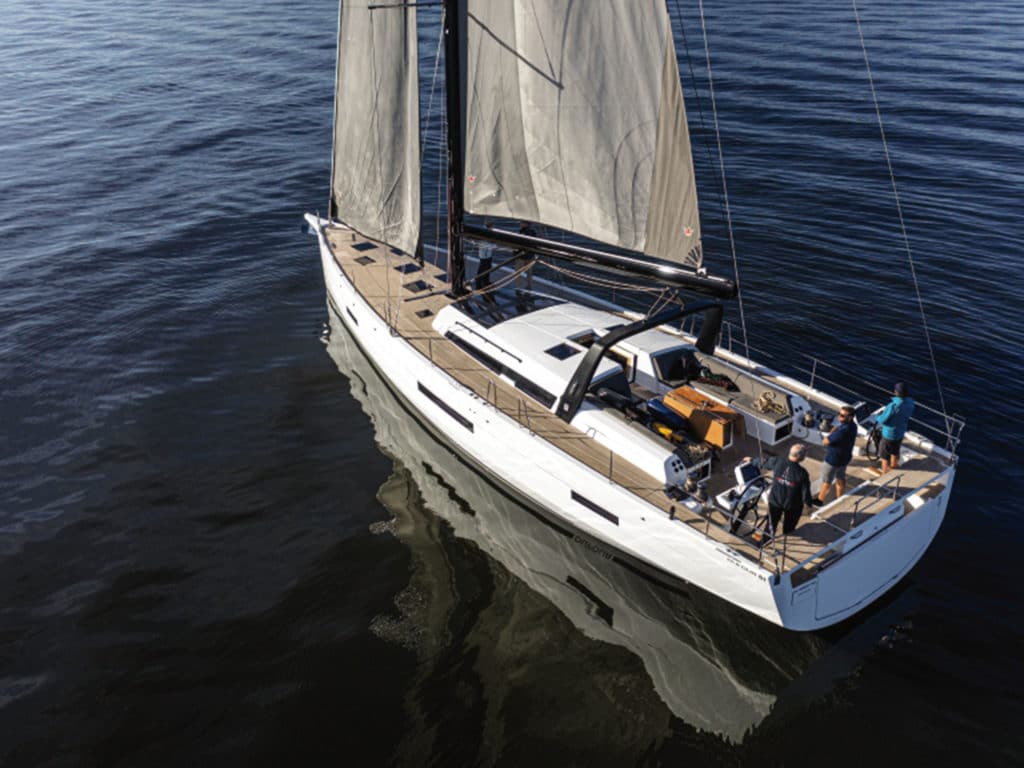
Compared with the 470 and other boats in the Dufour range, the 61 has quite a different look, especially on deck; while down below, she feels big for her size.
Rather than a Bimini and dodger, the 61’s topsides are wide open, save for a carbon-fiber arch over the companionway, on top of which the double-ended mainsheet is anchored with two blocks. This keeps the deck and coachroof free of lines when sailing.
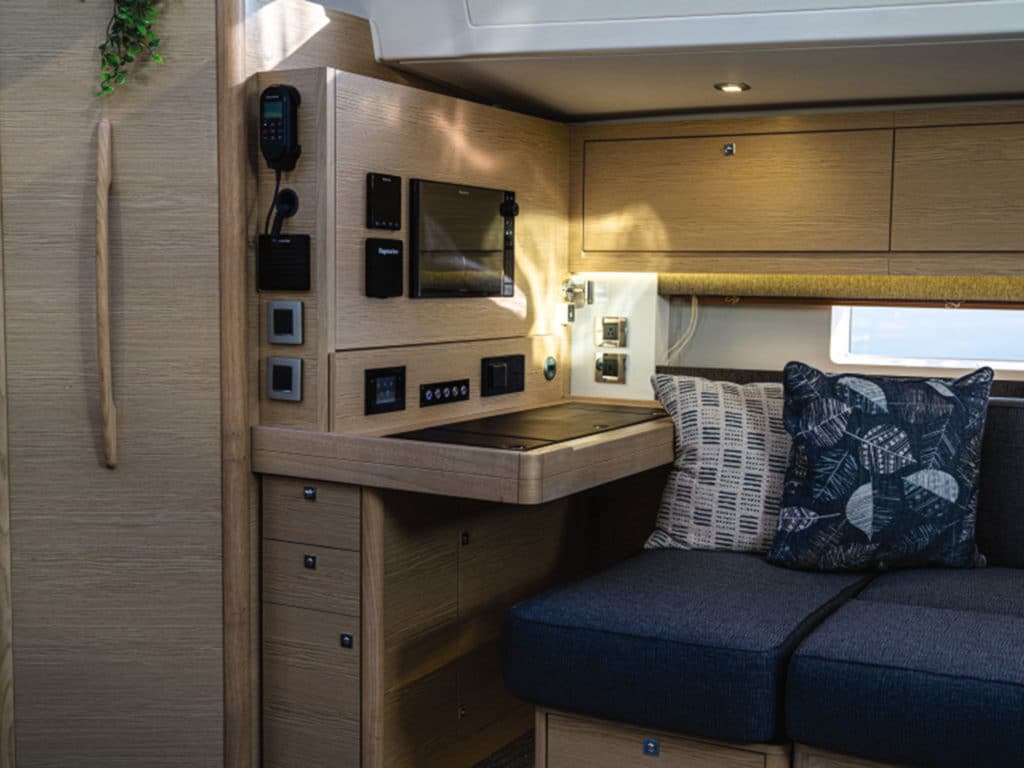
The low-profile cabin top, wide side decks, and expansive open foredeck definitely give the 61 a big-boat feel. Aft, with the swim platform down, there’s a large dinghy garage. One concern cited by the judges is that when loaded, the dinghy appears to cover the socket for the emergency tiller. Forward, there’s a large, deep sail locker, with access to the anchor chain, and with a few contortions, the motor for the below-deck electric headsail furler. The jib is self-tacking, and there are no genoa tracks or a molded place to mount them on the teak decks. As the company brochure reads, the boat was developed to provide “simple, instinctive sailing.”
Underway, all the actual work of tending canvas takes place at the twin wheels, where four electric winches give the helmsman fingertip control of all the required lines. Guests can be left to enjoy the spacious cockpit and its wide, drop-leaf centerline table with a fridge underneath.
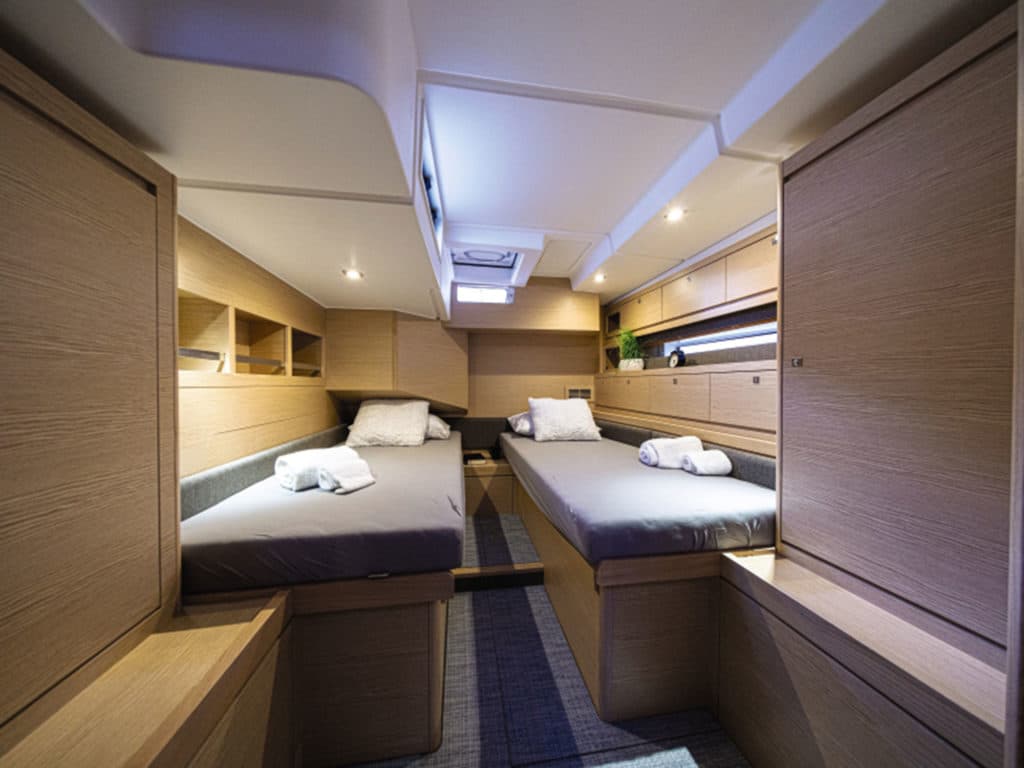
As with the 470, an owner has options below for family, guests and crew. The boat we visited had twin aft cabins; a Pullman berth with bunks to starboard, opposite the forward galley; and a unique owner’s cabin far forward that caught my eye, with a queen berth offset to port, and a head and shower compartment forward. Locating the galley aft, to port of the companionway, is also possible, as are a couple more sleeping-cabin layouts, providing berths for up to eight crew, plus a captain’s berth in the forepeak.
The 61 comes with a flagshiplike price tag of right around $1.3 million for a boat loaded up and ready to go. But thanks to the span of the Dufour range, an owner who appreciates the brand can start smaller and work themselves up to the 61, a few feet at a time.
Specifications
Dufour 470
| LENGTH OVERALL | 48’9″ (14.86 m) |
|---|---|
| WATERLINE LENGTH | 45’10” (13.97 m) |
| BEAM | 15’6″ (4.72 m) |
| DRAFT | 7’5″ (2.26 m) |
| SAIL AREA (100%) | 1,151 sq. ft. (106.9 sq. m) |
| BALLAST | 8,160 lb. (3,701 kg) |
| DISPLACEMENT | 29,101 lb. (13,200 kg) |
| BALLAST/DISPLACEMENT | 0.28 |
| DISPLACEMENT/LENGTH | 135 |
| SAIL AREA/DISPLACEMENT | 19.5 |
| WATER | 140 gal. (530 L) |
| FUEL | 250 gal. (946 L) |
| ENGINE | 60 hp Volvo, saildrive |
| DESIGNER | Felci Yachts Design |
| PRICE | $600,000 |
Dufour 61
| LENGTH OVERALL | 63’1″ (19.23 m) |
|---|---|
| WATERLINE LENGTH | 60’1″ (18.31 m) |
| BEAM | 16’5″ (5 m) |
| DRAFT | 9’2″ (2.79 m) |
| SAIL AREA (100%) | 1,829 sq. ft. (169.9 sq. m) |
| BALLAST | 14,330 lb. (6,500 kg) |
| DISPLACEMENT | 53,279 lb. (24,167 kg) |
| BALLAST/DISPLACEMENT | 0.27 |
| DISPLACEMENT/LENGTH | 110 |
| SAIL AREA/DISPLACEMENT | 20.7 |
| WATER | 226 gal. (855 L) |
| FUEL | 232 gal. (878 L) |
| ENGINE | 175 hp Volvo |
| DESIGNER | Felci Yachts Design |
| PRICE | $1,300,000 |
Dufour Yachts
240-278-8200
dufouryachts.com








